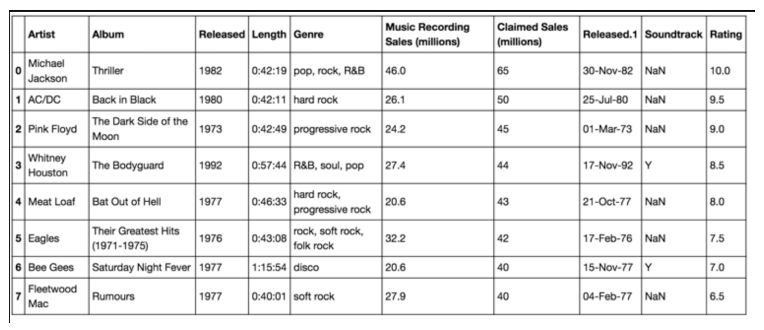python for data science ai & development coursera week 4 quiz answers
Practice Quiz
1. What are the most common modes used when opening a file?
- (a)ppend, (r)edline, (w)rite
- (s)ave, (r)ead, (w)rite
- (a)ppend, (r)ead, (w)rite
- (a)ppend, (c)lose, (w)rite
2. What is the data attribute that will return the title of the file?
- File1.open()
- File1.mode
- File1.name
- File1.close()
3. What is the command that tells Python to begin a new line?
- \n
- \q
- \b
- \e
4. What attribute is used to input data into a file?
- File1.close()
- File1.open()
- File1.write()
- File1.read()
5. What python object do you cast to a dataframe?
- set
- tuple
- dictionary
6. How would you access the first-row and first column in the dataframe df?
- df.ix[0,0]
- df.ix[0,1]
- df.ix[1,0]
7. What is the proper way to load a CSV file using pandas?
- pandas.from_csv(‘data.csv’)
- pandas.load_csv(‘data.csv’)
- pandas.read_csv(‘data.csv’)
- pandas.import_csv(‘data.csv’)
8. Use this dataframe to answer the question.

How would you select the Genre disco? Select all that apply.
- df.iloc[6, ‘genre’]
- df.loc[6, 5]
- df.iloc[6, 4]
- df.loc[‘Bee Gees’, ‘Genre’]
9. Use this dataframe to answer the question.

Which will NOT evaluate to 20.6? Select all that apply.
- df.iloc[4,5]
- df.iloc[6,5]
- df.loc[4,’Music Recording Sales’]
- df.iloc[6, ‘Music Recording Sales (millions)’]
10. Use this dataframe to answer the question.

How do we select Albums The Dark Side of the Moon to Their Greatest Hits (1971-1975)? Select all that apply.
- df.iloc[2:5, ‘Album’]
- df.loc[2:5, ‘Album’]
- df.iloc[2:6, 1]
- df.loc[2:5, 1]
11. What is the Python library used for scientific computing and is a basis for Pandas?
- Requests
- Tkinter
- Numpy
- datetime
12. What attribute is used to retrieve the number of elements in an array?
- a.size
- a.ndim
- a.shape
- a.dtype
13. How would you change the first element to "10" in this array c:array([100,1,2,3,0])?
- c[0]=10
- c[4]=10
- c[2]=10
- c[1]=10
14. What attribute is used to return the number of dimensions in an array?
- a.ndim
- a.shape
- a.size
- a.dtype
Module 4 Graded Quiz
15. What is the result of the following lines of code?
a=np.array([-1,1])
b=np.array([1,1])
np.dot(a,b)
- array([0,2])
- 1
- 0
16. How do you perform matrix multiplication on the numpy arrays A and B ?
- A+B
- A*B
- np.dot(A,B)
17. What values does the variable out take if the following lines of code are run?
X=np.array([[1,0,1],[2,2,2]])
out=X[0:2,2]
out
- array([1,0])
- array([1,2])
- array([1,1])
18. What is the value of Z after the following code is run?
X=np.array([[1,0],[0,1]])
Y=np.array([[2,1],[1,2]])
Z=np.dot(X,Y)
- array([[2,1],[1,2] ])
- array([[2,0],[1,0]])
- array([[3,1],[1,3] ])
19. Consider the following text file: Example1.txt:
This is line 1
This is line 2
This is line 3
What is the output of the following lines of code?
with open("Example1.txt","r") as File1:
file_stuff=File1.readline ()
print(file_stuff)
- This is line 1
This is line 1
This is line 2
This is line 3
This is line 1
This is line 2
20. What do the following lines of code do?
with open("Example1.txt","r") as file1:
FileContent=file1.readlines()
print(FileContent)
- Read the file “Example1.txt”
- Write to the file “Example1.txt”
- Append the file “Example1.txt”
21. What do the following lines of code do?
with open("Example.txt","a") as writefile:
writefile.write("This is line A\n")
writefile.write("This is line B\n")
- Write to the file “Example.txt”
- Read the file “Example.txt”
- Append the file “Example.txt”
22 What task do the following lines of code perform?
with open('Example2.txt','r') as readfile:
with open('Example3.txt','w') as writefile:
for line in readfile:
writefile.write(line)
- Copy the text from Example2.txt to Example3.txt.
- Print out the content of Example2.txt.
- Check the mode of the open function for each file object.
23. Consider the dataframe df. How would you access the element in the 2nd row and 1st column?
- df.iloc[1,0]
- df.iloc[2,1]
- df.iloc[0,1]
24. In the lab, you learned you can also obtain a series from a dataframe df, select the correct way to assign the column with the header Length to a pandas series to the variable x.
- x=df[‘Length’]
- x=df[[‘Length’]]
- x=df.[[‘Length’]]
